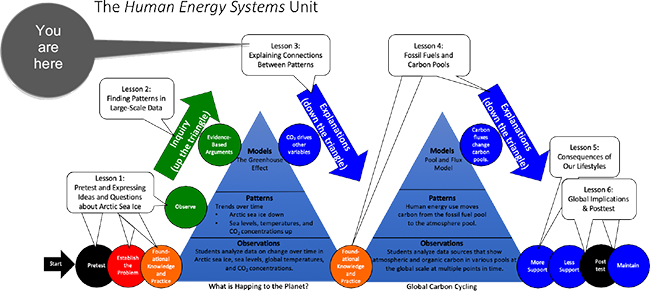Transformations in Matter and Energy Carbon TIME is an NSF-funded partnership led by Michigan State University
Human Energy Systems | Lesson 3 - Explaining Connections between Patterns
Overview
Students examine the relationship between atmospheric CO2 and atmospheric temperature rise.
Guiding Question
How are changes in global temperatures, sea levels, Arctic sea ice, and atmospheric CO2 connected?
Activities in this Lesson
- Activity 3.1 Millions of Flasks of Air (25 minutes)
- Activity 3.2 The Greenhouse Effect Reading & Simulation (20 minutes)
- Activity 3.3 Relationships between Earth Systems (40 minutes)
Unit Map

Target Student Performance
|
Activity |
Target Performance |
|
Lesson 3 – Explaining Connections between Patterns (students as explainers) |
|
|---|---|
|
Activity 3.1: Millions of Flasks of Air (25 min) |
Students explain why Charles David Keeling went to Hawaii to collect data on atmospheric CO2 concentrations and how he made his measurements. |
|
Activity 3.2: The Greenhouse Effect (20 min) |
Students use a computer simulation to explain how carbon dioxide absorbs visible light and emits infrared radiation—the Greenhouse Effect. |
|
Activity 3.3: Explaining Relationships Between Earth Systems (40 min) |
Students use the Greenhouse Effect to explain how atmospheric CO2 concentration is the driver that causes changes in other Earth systems. |
NGSS Performance Expectations
High School
- Ecosystems: Interactions, Energy, and Dynamics. HS-LS2-5. Develop a model to illustrate the role of photosynthesis and cellular respiration in the cycling of carbon among the biosphere, atmosphere, hydrosphere, and geosphere.
- Earth’s Systems. HS-ESS2-2. Analyze geoscience data to make the claim that a change to Earth’s surface can create feedbacks that cause changes to other Earth systems.
- Weather and Climate. HS-ESS2-4. Use a model to describe how variations in the flow of energy into and out of Earth’s systems result in changes in climate.
- Earth and Human Activity. HS-ESS3-5. Analyze geoscience data and the results from global climate models to make an evidence-based forecast of the current rate of global or regional climate change and associated future impacts to Earth systems.
- Earth and Human Activity. HS-ESS3-6. Use a computational representation to illustrate the relationships among Earth systems and how those relationships are being modified due to human activity.
Middle School
- Waves and Electronic Radiation. MS-PS4-2. Develop and use a model to describe that waves are reflected, absorbed, or transmitted through various materials.
- Earth’s Systems. MS-ESS2-1. Develop a model to describe the cycling of the Earth’s materials and the flow of energy that drives this process.
- Human Impacts. MS-ESS3-4. Construct an argument supported by evidence for how increases in human population and per-capital consumption of natural resources impact Earth's systems.
- Earth and Human Activity. MS-ESS3-5. Ask questions to clarify evidence of the factors that have caused the rise in global temperatures over the past century.

 Download PDF of Lesson 3 Teacher's Guide
Download PDF of Lesson 3 Teacher's Guide